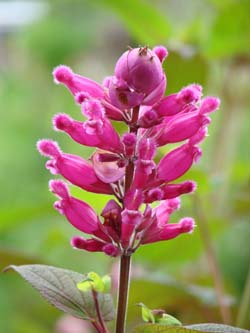(Rosebud Pink Hybrid Sage) Protective, magenta pink, leaf-like bracts surround the buds of Salvia pulchella x involucrata like a hug, bursting open and eventually falling away as the fuzzy flowers blossom.
The involucrata part of the botanical name refers to involucres -- clusters of buds wrapped in bracts. Before emerging, the flowers and bracts are tightly furled similar to rosebuds.
Pulchella is Latin for "beautiful." It's a description that is particularly apt during cool months when Rosebud Pink Hybrid Sage is long blooming in areas with moderate climates.
Heart-shaped and Kelly green, the leaves contrast brightly with this shrub's dark maroon stems. It spreads almost as wide as its height, which is relatively short for a Rosebud Sage.
Give this compact sage full sun to partial shade and rich, well-drained soil. Although it loves moisture, it only requires average watering based on local conditions. This is a good choice for container planting.
Hummingbirds love this plant selected by longtime California plantsman and biologist Martin Grantham, manager of the San Francisco State University's biology department greenhouse.
Question?

